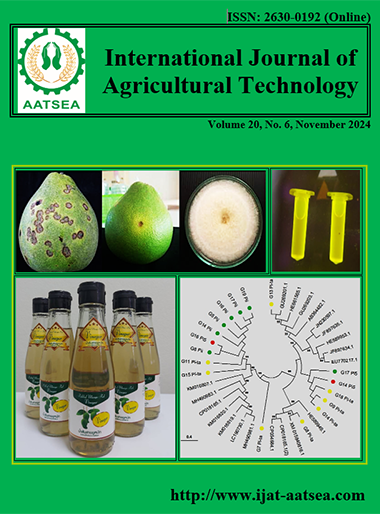Mapping soil nutrients and texture for the pilot project of glutinous rice variety Pulut Siding (MR 47) in Langkawi Island, Malaysia
Main Article Content
Abstract
The soil nutrient and texture status in four rice areas, namely Kg. Ayer Hangat, Kg. Batu Duyung, Kg. Baru/Teluk, and Kg. Ulu Melaka on Langkawi Island, Malaysia was successfully analysed using Geographic Information System (GIS) techniques. The results indicated no significant variations in organic carbon, cation exchange capacity (CEC), and conductivity among the study areas. However, distinctive differences were observed in soil chemical features, including pH values, total nitrogen, available phosphorus, and exchangeable potassium—specifically, the rice fields in Kg. Ayer Hangat exhibited a significantly lower pH (4.68) compared to Kg. Batu Duyung (5.23) and Kg. Baru/Teluk (5.09). Total nitrogen content was notably higher in Kg. Ayer Hangat (0.18). Available phosphorus showed significant variations, with Kg. Batu Duyung recorded the highest (37.32 mg/kg) and Kg. Ayer Hangat is the lowest (15.25 mg/kg). Exchangeable potassium levels were markedly higher in Kg. Ulu Melaka (0.53 cmol(+)/kg) compared to Kg. Ayer Hangat (0.29 cmol(+)/kg), while Kg. Batu Duyung and Kg. Baru/Teluk recorded lower levels (0.19 cmol(+)/kg and 0.08 cmol(+)/kg, respectively). Furthermore, Soil Taxonomy (ST) was employed to categorize soils, with the majority falling under hydrologic soil group A, primarily sandy loam types. Kg. Ayer Hangat, however, was categorized under hydrologic soil group C (sandy clay loam). The study suggests that additional research may be conducted to assess the practical implementation of soil nutrient mapping and texture in small plantation systems. This could potentially bridge the gap between research findings and practical applications
Article Details

This work is licensed under a Creative Commons Attribution-NonCommercial-NoDerivatives 4.0 International License.
References
Aimrun, W., Amin, M. S. M. and Nouri, H. (2011). Paddy field zone characterization using apparent electrical conductivity for rice precision farming. International Journal of Agricultural Research, 6:10-28.
Aishah, A. W., Zauyah, S., Anuar, A. R. and Fauziah, C. I. (2010). Spatial variability of selected chemical characteristics of paddy soils in Sawah Sempadan, Selangor, Malaysia. Malaysian Journal of Soil Science, 14:27-39.
Burbos, R. O. and Lyn, R. (2023). Physico-chemical assessment of rice soils in Quirino Province, Phillipines. International Journal of Biomedicine and Life Sciences, 8:110.
Chatterjee, S., Santra, P., Majumdar, K., Ghosh, D., Das, I. and Sanyal, S. K. (2015). Geostatistical approach for management of soil nutrients with special emphasis on different forms of potassium considering their spatial variation in intensive cropping system of West Bengal, India. Environmental Monitoring and Assessment, 187:1-17.
Dou, F., Soriano, J., Tabien, R. E. and Chen, K. (2016). Soil texture and cultivar effects on rice (Oryza sativa, L.) grain yield, yield components and water productivity in three water regimes. PloS ONE, 11:e0150549.
Eltaib, S. M., Soom, M. A. M., Hanafi, M. M., Shariff, A. R. M. and Wayayok, A. (2002). Spatial variability of N, P, and K in rice field in Sawah Sempadan, Malaysia. Songkhlanakharin Journal of Science and Technology, 24:321-328.
Jamru, L. R., Sharil, M. N. and Yusoh, M. P. (2023). Assessing the evolution of paddy cultivation in Kota Belud, Sabah using GIS and remote sensing techniques. Journal of the Malaysian Institute of Planners, 21:204-216.
Lee, D. -B., Kim, Y. -N., Sonn, Y. -K. and Kim, K. -H. (2023). Comparison of soil taxonomy (2022) and WRB (2022) systems for classifying paddy soils with different drainage grades in South Korea. Land, 12:1204.
Lee, S. H., Yoo, S. H., Choi, J. Y. and Engel, B. A. (2016). Effects of climate change on paddy water use efficiency with temporal change in the transplanting and growing season in South Korea. Irrigation Science, 34:443-463.
Mandal, A. K. and Sharma, R. C. (2009). Computerized database of salt affected soils for Peninsular India using GIS. Geocarto International, 24:65-85.
Mandal, H. R., Shah, S. K., Oli, B., Katel, S., Yadav, S. P. S., Pant, K. R., Lamshal, B. S., Kattel, S., Sah, S. and Yadav, B. (2023). Assessment of soil fertility status in Rupani Rural Municipality, Saptari, Nepal. AgroEnvironmental Sustainability, 1:111-121.
Minnesota Pollution Control Agency. (2023). Soil classification - Minnesota Stormwater Manual. Retrieved from https://stormwater.pca.state.mn.us/index.php?title=Soil_classification
Mishra, A., Das, D. and Saren, S. (2013). Preparation of GPS and GIS based soil fertility maps for Khurda district, Odisha. Indian Agriculturist, 57:11-20.
Pheav, S., Bell, R. W., Kirk, G. J. D. and White, P. F. (2005). Phosphorus cycling in rainfed lowland rice ecosystems on sandy soils. Plant Soil, 269:89-98.
Safitri, D. E., Ahmad, A. and Nathan, M. (2021). Study of soil management in rice fields in Bantimurung District Maros Regency. IOP Conference Series: Earth and Environmental Science, 807:042008. IOP Publishing.
Sarkar, I. U., Isalm, N., Jahan, A., Islam, A. and Biswas, J. C. (2017). Rice straw as a source of potassium for wetland rice cultivation. Geology, Ecology and Landscapes, 1:184-189.
Soil Survey Staff. (2022). Keys to Soil Taxonomy, 13th edition. USDA Natural Resources Conservation Service.
Swati Sucharita, Rautaray, S. K., Satapathy, M. R. and Nayak, R. K. (2023). Zinc fertilizer application improves growth, yield and profit of paddy (Oryza sativa L.) in a zinc deficient Inceptisol. ORYZA-an International Journal on Rice, 60:196-202.
Tobore, A., Senjobi, B., Ogundiyi, T. and Bamidele, S. (2021). Geospatial assessment of wetland soils for rice production in Ajibode using geospatial techniques. Open Geosciences, 13:310-320.
Wihardjaka, A., Harsanti, E. S. and Ardiwinata, A. N. (2022). Effect of fertilizer management on potassium dynamics and yield of rainfed lowland rice in Indonesia. Chilean Journal of Agricultural Research, 82:33-43.
Yang, M., Sakruaba, Y., Ishikawa, T., Ohtsuki, N., Kawai‐Yamada, M. and Yanagisawa, S. (2023). Chloroplastic Sec14-like proteins modulate growth and phosphate deficiency responses in Arabidopsis and rice. Plant Physiology, 192:3030-3048.
Yang, Y. and Zhang, S. (2008). Approach of developing spatial distribution maps of soil nutrients. In: Li, D. (eds) Computer and computing technologies in agriculture, volume I. CCTA 2007. The International Federation for Information Processing, volume 258, Boston, Springer, pp.565-571.


